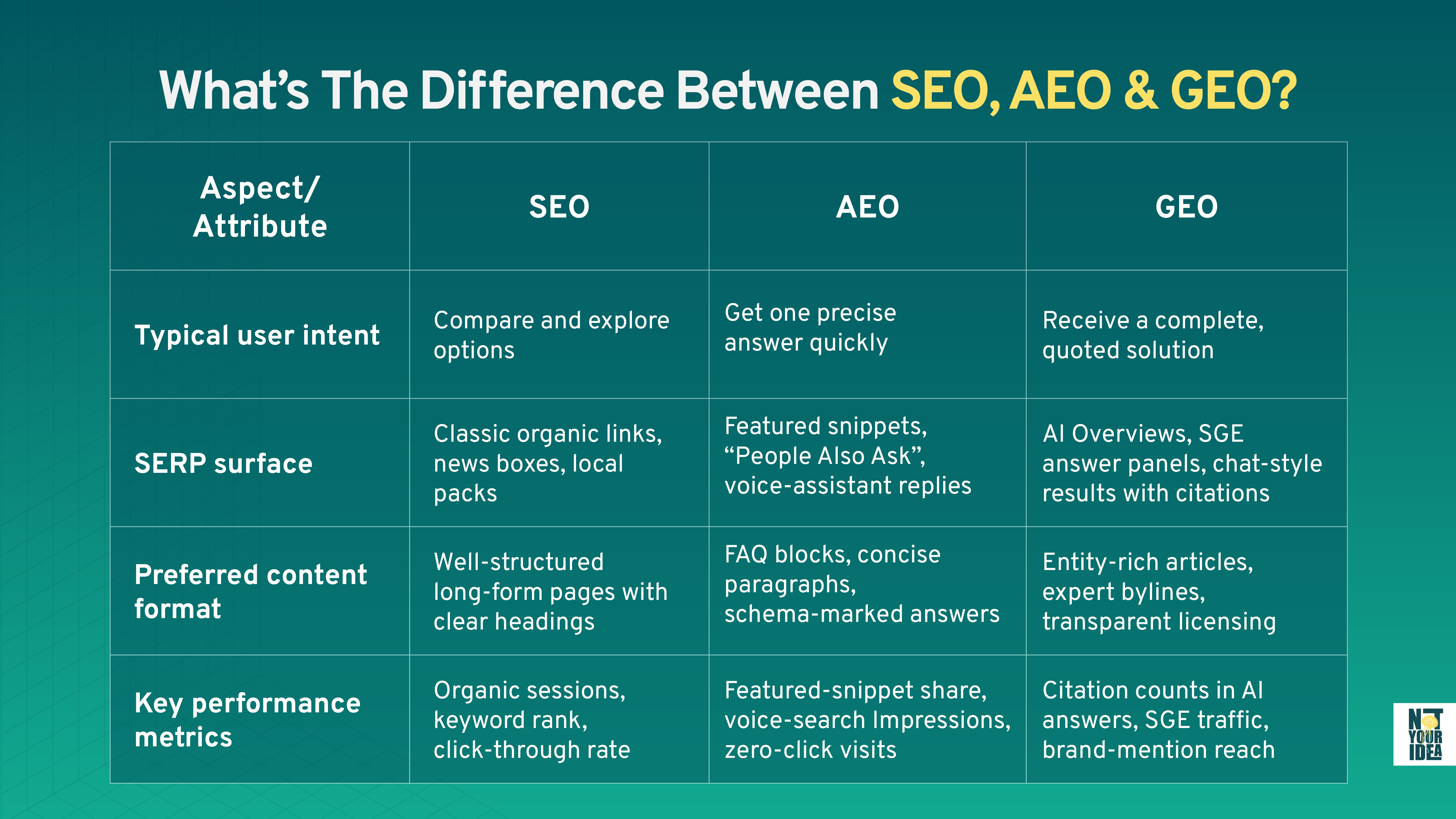From typing out queries to asking voice assistants to getting end-to-end AI curated responses without needing to click on anything—Search has evolved, and how! The world over, we find ourselves caught in the crosscurrents of several rapid changes, and uncertainty is all around. The need of the hour is to familiarize ourselves with Search’s three pillars: SEO, AEO, and GEO. We’re breaking them down into their core features and differences, alongside clear takeaways on when and how to prioritize each optimization layer.
SEO, AEO, and GEO: What Are They?
SEO (Search Engine Optimization) remains the same as we’ve always understood it—the aim is to win blue-link rankings on classic Search Engine Results Pages. Its focus is on improving website visibility across the results through tactics like keyword optimization, content quality, and technical improvements. AEO and GEO are relatively newer concepts, with the latter being the latest, and both are related to the advent of AI.
AEO (answer engine optimization) focuses on concise answers in featured snippets, voice results, AI “answer boxes”, and responses on answer engines like Gemini, Perplexity, and Claude. It’s a strategy that targets conversational queries on platforms providing direct answers, i.e., without the user needing to click on further links.
GEO (generative engine optimization) focuses completely on being quoted or cited in AI-generated summaries such as Google AI Overviews, Perplexity, or ChatGPT replies that generate responses using multiple sources. GEO specifically targets research-based AI interactions.
Across the three is a visible shift in user-intent—Search tools have evolved to grow in convenience for the user, and in response, user queries have moved from ‘type - click - research’ (SEO) to ‘show a direct answer’ (AEO) to ‘a thorough solution to a multi-layered query’ (GEO).
What’s the Difference Between SEO, AEO & GEO? A Snapshot

Content Strategy Variations
Though all three optimization strategies hover around content optimization, there are differences in what formats work best for each.
SEO
Long-form, well-structured content that gives readers (and site crawlers) everything they need is the best approach for SEO. Long guides, comparison pieces, and tightly linked “pillar and cluster” articles build topical depth, which is always an algorithm pleaser. Clear headings, internal links, and naturally plugged keywords help Google understand context, while periodic updates keep the URL relevant without breaking existing rank signals.
AEO
A stark contrast to the long-form preference of SEO is the conciseness of AEO, where the priority is to craft a crystal-clear reply that can be plucked and placed into SERP Features like the featured snippet, or be spoken aloud by a voice assistant. An ideal structure comprises a brief definition or summary, followed by short paragraphs of explanations and FAQ blocks. Marking those blocks with schema such as FAQPage, HowTo, or Speakable tells crawlers where the answer begins and ends, increasing the odds of winning the coveted zero-click spot.
GEO
Generative Engine Optimization adds yet another layer. Entity-rich, highly cited, expert-authored content works best for GEO. Large language models look for authoritative paragraphs they can quote safely, so provide transparent sourcing, bylines with real expertise, and even usage licenses.
In practice, the three strategies overlap. Strong SEO foundations supply the crawlable site structure; AEO techniques refine sections into neat, machine-readable answers; and GEO practices ensure those answers are credible enough to show up in AI-generated summaries.
The Technical Differences Between SEO, AEO & GEO
While site speed, mobile responsiveness, crawlability, and indexing remain crucial to all three, each approach adds specific technical requirements. Core Web Vitals and backlinking remain foundational to SEO. Metadata is tuned for clicks: 55–60-character title tags that front-load the core keyword and meta descriptions are worded as persuasive ad copy.
Mobile optimization and page speed are the most essential for AEO, as most voice searches occur on mobile devices. Metadata is stripped to its essence: titles often mirror the user’s question verbatim, while meta descriptions restate the 40-word answer to improve zero-click visibility and voice-assistant fidelity.
GEO introduces new considerations for AI crawlers, focusing on content accessibility for AI systems, information architecture that supports comprehensive understanding, and ensuring content can be easily cited by AI. Metadata widens in scope: titles include distinctive entities to increase citation odds; meta descriptions highlight statistics or named sources because LLMs favor passages with concrete data.
Measurement tools have also evolved to track progress and success. Traditional SEO relies on Google Analytics and Search Console for traffic and ranking. AEO requires tracking featured snippet captures and monitoring voice search visibility, with tools like SEMrush and Ahrefs beginning to incorporate such features. GEO measurement is the newest frontier, demanding monitoring of brand mentions in AI responses, citation frequency, and authority signals. As of the moment, custom solutions and new metrics focused on thought leadership rather than traditional traffic are in the limelight.
Is SEO Still Relevant?
In the current scenario, SEO remains the foundation to drive website traffic. The bigger question that people have been asking is, is traffic even relevant anymore? According to a 2024 prediction by Gartner, a technological research and consulting firm, traditional search engine volume will drop 25% by 2026.
While it’s certainly true that traffic impact remains moderate, abandoning traditional SEO and traffic isn’t a wise choice. Visitors who land on your website and find helpful and relevant information are likely to be higher-quality leads. More importantly, AI chatbots aren’t just pulling information from the internet—they’re curating answers based on content reliability and authority. When someone asks, “How do I start investing?” it’s the high-quality, well-organized content from credible sites that gets chosen.
Naturally, if traffic isn’t the be-all and end-all to organic success, SEO too isn’t the only path to choose. A future-ready strategy involves adopting an integrated content approach where the aim is to create expertise-driven content that serves traditional search, answers voice queries, and provides AI-worthy citations simultaneously.
How Do I Choose Between SEO, AEO & GEO?
The choice isn’t among which of the three to focus on, but how much of each you need to focus on. Your content should include a synergy of all three optimization approaches: Develop comprehensive pieces that include keyword-optimized content, FAQ sections for voice search, and authoritative information for AI citations. Implement schema markup that serves all three optimization types while maintaining site performance, and track SEO rankings, voice search captures, and AI mentions in unified reporting systems. Regularly update your content to reflect the latest trends, emerging questions, and industry conversations, helping with freshness signals for GEO.
Content production teams must learn how to adapt to conversational content writing, how to optimize content for AI, and what the new measurement metrics are. More importantly, align your content creators, AI optimization experts, and your technical SEO specialists to function cohesively.
Put simply, strong SEO foundations boost both AEO and GEO; AEO tactics (clear answers, schema) directly feed GEO; GEO additionally values “human-bylined expertise” and freshness signals. A balanced content calendar now reserves a majority of effort for evergreen SEO (50-60%), sets aside blocks and schema for question-oriented AEO (30%), and experiments with expert-driven, citation-ready GEO to secure visibility as search keeps evolving (10-20%).
FAQs
What are SEO, AEO, and GEO?
SEO (Search Engine Optimization) improves website visibility on search engines like Google, AEO (Answer Engine Optimization) optimizes content for featured snippets and voice search, while GEO (Generative Engine Optimization) targets AI platforms like ChatGPT and Google's SGE.
What are the 3 pillars of SEO?
The three pillars are Technical SEO (site speed, indexing), On-page SEO (content, keywords), and Off-page SEO (backlinks, domain authority).
How to use Answer Engine Optimization?
AEO needs clear, concise, and structured content that answers specific user questions. Headings, bullet points, FAQs, and schema markup must be added for better visibility in featured snippets or voice search.
What is an Example of AEO?
Consider a recipe website optimizing their content to appear in Google's featured snippet when someone searches "how to make chocolate chip cookies"; they do this by structuring their recipe with clear headings, numbered steps, and concise ingredient lists. This helps search engines to easily extract and display it as a direct answer, showcasing effective AEO.
What is the Difference Between AEO and SEO?
SEO focuses more on improving rankings in search engines, while AEO specifically targets visibility in answer boxes, voice results, and AI-driven answer engines by optimizing for clarity and structure.
What is Generative Engine Optimization?
Generative Engine Optimization (GEO) is the practice of structuring and crafting content so it is accurately and prominently referenced by AI models and generative search tools like ChatGPT, Bing Copilot, or Google SGE.
If you’re on the lookout for an agency that’s keeping up with the times, Not Your Idea is bound to help. A content and search engine optimization agency, we keep our ears to the ground to help you find sustainable digital solutions for all your needs.



